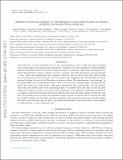Files in this item
Orbiting clouds of material at the Keplerian co-rotation radius of rapidly rotating low mass WTTs in Upper Sco
Item metadata
| dc.contributor.author | Stauffer, John | |
| dc.contributor.author | Collier Cameron, Andrew | |
| dc.contributor.author | Jardine, Moira | |
| dc.contributor.author | David, Trevor | |
| dc.contributor.author | Rebull, Luisa | |
| dc.contributor.author | Cody, Ann Marie | |
| dc.contributor.author | Hillenbrand, Lynne | |
| dc.contributor.author | Barrado, David | |
| dc.contributor.author | Wolk, Scott | |
| dc.contributor.author | Davenport, James | |
| dc.contributor.author | Pinsonneault, Marc | |
| dc.date.accessioned | 2017-03-03T09:30:12Z | |
| dc.date.available | 2017-03-03T09:30:12Z | |
| dc.date.issued | 2017-03-10 | |
| dc.identifier | 249268015 | |
| dc.identifier | 51c87704-ad1f-4afd-8a52-f0679d873af1 | |
| dc.identifier | 85017387377 | |
| dc.identifier | 000397602200001 | |
| dc.identifier.citation | Stauffer , J , Collier Cameron , A , Jardine , M , David , T , Rebull , L , Cody , A M , Hillenbrand , L , Barrado , D , Wolk , S , Davenport , J & Pinsonneault , M 2017 , ' Orbiting clouds of material at the Keplerian co-rotation radius of rapidly rotating low mass WTTs in Upper Sco ' , Astronomical Journal , vol. 153 , no. 4 , 152 . https://doi.org/10.3847/1538-3881/aa5eb9 | en |
| dc.identifier.issn | 0004-6256 | |
| dc.identifier.other | BibCode: 2017arXiv170201797S | |
| dc.identifier.other | ORCID: /0000-0002-8863-7828/work/58531523 | |
| dc.identifier.other | ORCID: /0000-0002-1466-5236/work/57821906 | |
| dc.identifier.uri | https://hdl.handle.net/10023/10395 | |
| dc.description.abstract | Using K2 data, we have identified 23 very low mass members of the ρ Oph and Upper Scorpius star-forming region as having periodic photometric variability not easily explained by well-established physical mechanisms such as star spots, eclipsing binaries, or pulsation. All of these unusual stars are mid-to-late M dwarfs without evidence of active accretion, and with photometric periods generally <1 day. Often the unusual light curve signature takes the form of narrow flux dips; when we also have rotation periods from star spots, the two periods agree, suggesting that the flux dips are due to material orbiting the star at the Keplerian co-rotation radius. We sometimes see “state-changes” in the phased light curve morphologies where ∼25% of the waveform changes shape on timescales less than a day; often, the “state-change” takes place immediately after a strong flare. For the group of stars with these sudden light curve morphology shifts, we attribute their flux dips as most probably arising from eclipses of warm coronal gas clouds, analagous to the sling-shot prominences postulated to explain transient Hα absorption features in AB Doradus itself and other rapidly rotating late type stars. For another group of stars with somewhat longer periods, we find the short duration flux dips to be highly variable on both short and long timescales, with generally asymmetric flux dip profiles. We believe that these flux dips are due to particulate clouds possibly associated with a close-in planet or resulting from a recent collisional event. | |
| dc.format.extent | 8214926 | |
| dc.language.iso | eng | |
| dc.relation.ispartof | Astronomical Journal | en |
| dc.subject | Stars: low-mass | en |
| dc.subject | Stars: pre-main sequence | en |
| dc.subject | QC Physics | en |
| dc.subject | QB Astronomy | en |
| dc.subject | 3rd-DAS | en |
| dc.subject.lcc | QC | en |
| dc.subject.lcc | QB | en |
| dc.title | Orbiting clouds of material at the Keplerian co-rotation radius of rapidly rotating low mass WTTs in Upper Sco | en |
| dc.type | Journal article | en |
| dc.contributor.sponsor | Science & Technology Facilities Council | en |
| dc.contributor.institution | University of St Andrews. School of Physics and Astronomy | en |
| dc.contributor.institution | University of St Andrews. St Andrews Centre for Exoplanet Science | en |
| dc.identifier.doi | 10.3847/1538-3881/aa5eb9 | |
| dc.description.status | Peer reviewed | en |
| dc.identifier.url | http://adsabs.harvard.edu/abs/2017arXiv170201797S | en |
| dc.identifier.grantnumber | ST/M001296/1 | en |
This item appears in the following Collection(s)
Items in the St Andrews Research Repository are protected by copyright, with all rights reserved, unless otherwise indicated.

